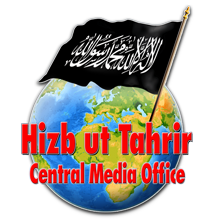بسم الله الرحمن الرحيم
Sudan’s Leaders are Continuing to Implement America’s Plan to Tear their Country Apart
By: Ustaadh Hatem Al-Attar - Wilayah Egypt
(Translated)
Al-Rayah Newspaper - Issue 570 - 22/10/2025
First: The current conflict in Sudan
Since the outbreak of the December 2018 revolution, Sudanese public opinion has been directed, via the media and intelligence services, toward two options: either a democratic civilian government or a military government. This directive was not innocent. Instead, it was part of a premeditated preparation for an internal war serving an international project aimed at tearing Sudan apart, as Lieutenant General Abdel Fattah al-Burhan, Chairman of the Sovereignty Council, stated on June 27, 2023, when he said, “Our country is being subjected to a conspiracy whose motives are to tear apart the country’s unity.”
The US strategy toward Sudan is not separate from its policy in East and Central Africa. Instead, it views Sudan as a gateway to the resource-rich continent, as stated by US Special Envoy to Sudan Scott Gration, and confirmed by US President Trump, who stated that Sudan is a priority for US foreign policy.
Second: The purpose of tearing apart
Sudan represents a strategic threat to America's interests in Africa, not only because of its location and wealth, but also because of its people’s adherence to Islam, their deep connection to the Noble Quran and their love for the Prophet Muhammad (saw).
Despite the absence of a state that practically implements Islam, America and Europe fear that Sudan could become a base for a truly Islamic project. Therefore, they seek to completely secularize Sudan and dismantle its Islamic moral values.
Third: Sudan’s wealth
As Napoleon said, “Money has no motherland; financiers are without patriotism and without decency; their sole object is gain.” Sudan is an exceptionally rich country:
- Area before the secession of the South: 1 million square miles (2.5 million km2)
- Oil production: 300,000 barrels per day, with reserves exceeding 3 billion barrels
- Gold: The third-largest global producer, with reserves estimated at 1,550 tons
- Agriculture: 200 million acres are arable, of which 64 million are cultivated
- Pastures: 115 million acres
- Arabic Gum: Sudan produces 80% of the world's production, monopolized by American companies
- Uranium: Sudan is one of the richest countries in this mineral
Fourth: Tools of Disruption
America is using five main tools to disintegrate Sudan:
1- The Sudanese government
2- Armed rebel movements
3- The political opposition
4- The statelet of South Sudan
5- International and regional organizations
However, the most dangerous tool is the military and security leadership, which represents the centers of power in Sudan: the army, the Rapid Support Forces, the security apparatus, and the police.
America has relied on these leaders since al-Bashir’s era and until Burhan’s to implement its plan.
The Sudanese leaders’ interest in implementing America's plan
The interest of some Sudanese leaders in enabling the implementation of America’s criminal plan to tear the country apart is evident in their direct connection to American and Western support, which is the only guarantee for their continued rule.
- Some believe that their continued rule is tied to external support, not to their nationalistic legitimacy or the people's love for them.
- They rely on the political, financial, and military protection provided by America and Western countries, for which they pay the price by implementing agendas that re-fragment Sudan and dismantle its institutions.
- They prioritize their personal interests above all else, as this support keeps them from internal accountability.
- They use tribal and ethnic conflicts as a means to keep the country’s people preoccupied and distracted, ensuring their continued dominance and preventing any real opposition from expanding.
- These leaders do not desire to build a strong, unified country. Instead, they prefer division so that they can remain the powerful ones controlling parts of the state.
The United States and its proxies consider them the sole guarantor of the stability of their interests in the region, so they provide them with political cover and protection in exchange for implementing their plan in Sudan.
Fifth: The starting point - the Naivasha Agreement
The Bashir regime signed the Naivasha Agreement in 2005, which led to the secession of the South, breaking Sudan's back militarily and politically. Bashir admitted in a cabinet meeting on September 30, 2010, “We put the country’s unity at risk in exchange for achieving peace through the secession of the South.”
The most dangerous provisions of the agreement were the dismantling of the Sudanese army, the consolidation of tribalism and regionalism, and the arming of tribal groups against one another, leading to bloodshed in Darfur, Kordofan, Blue Nile, and now Khartoum.
Sixth: Obstacles to fragmentation - the British-American conflict
Although the two colonial powers agree on tearing Sudan apart, they differ on how to divide its resources. The conflict between Britain and America over Sudan continues, with each side seeking to empower its political and armed militia tools.
After the December revolution, power was transferred to the Military Council through the Security Committee, and the first steps of a partnership with the Forces of Freedom and Change began. America seeks to expel British influence through a sham partnership capable of being overturned at any moment. Indeed, the current war in Sudan is the most recent scenario of international conflict.
Sudan can only achieve stability under the current complex circumstances by expelling colonialism in all its forms and by adopting the Ummah’s project, the project of the Second Khilafah Rashidah (Rightly Guided Caliphate) on the Method of Prophethood. This project alone is capable of uprooting the influence of America and the West, which covet our country and plunder our wealth, forcing us to live a life of division, chaos, hunger, backwardness, and disease.




